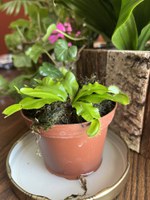Dakota Gardener: Carnivorous plants
(Click an image below to view a high-resolution image that can be downloaded)
By Carrie Knutson, Horticulture agent
NDSU Extension – Grand Forks County
My daughter received a Venus fly trap plant for her birthday. I won’t say who gave it to her, but you can probably guess. Right away we had to research how to care for the plant. The gift giver really should have done her homework first. Work will be needed to ensure the plant survives in our indoor environment.
Venus fly trap plants are carnivorous plants. Carnivorous plants are unique because they can trap and kill insects. Usually, carnivorous plants grow in acidic soil lacking nutrients. The plants use the extra nutrients from the insects to supplement their nutritional needs.
Carnivorous plants will not survive outdoors in North Dakota. Some species can survive mild winters, but most prefer the warmer climates farther south. Some species of Venus fly traps are native to areas in North and South Carolina.
The Venus fly trap plant has two shelled-shaped leaves that form the trap. The leaves have tough guard hairs on the edge that kind of look like teeth. When an unlucky insect triggers the small hairs on the inside of the leaves, the leaves close. The leaves trap the insect and release acids to digest the insect.
The book “Growing Carnivorous Plants” by Barry A. Rice provides valuable information for growing Venus fly traps as well as other carnivorous plants. Venus fly trap potting media is typically a 1:1 ratio of sand and peat moss and there are commercial mixes available on the market.
To survive indoors, the Venus fly trap plant needs warmth and humidity that imitates the conditions of their native range. For example, warm summers (80 degrees Fahrenheit) and cool winters (60 degrees Fahrenheit) with humidity of 50% to 80%. As a result, Venus fly traps are most often grown in closed terrariums or in a tray with rocks and water. It is recommended to water with purified or distilled water.
In its native environment, the flowers of a Venus fly trap plant are good for pollinators. However, they can be removed from plants grown indoors as they use lots of energy.
While Venus fly trap plants can use photosynthesis to produce food, they rely on trapping insects to supplement their nutrients. This is something that you will have to help the plant with when growing it indoors.
Insects for food should be about one-third as long as the trap. Insects can be put in the freezer so that it is easier to place them in in the trap. It is not recommended to feed Venus fly trap plants raw meat as it can cause bacterial issues and harm the plant.
Shockingly, insects are in short supply in winter. So, we are hoping our plant is in good enough health to grow until we can hunt down some insects this spring. Maybe I can catch some fungus gnats at work.
Lesson learned (again), it is helpful to research a plant before you buy it to make sure you have the correct environment for it to grow. So you or I won’t have to say, “I tried, but it died.” Happy gardening.
NDSU Agriculture Communication – March 21, 2023
Source: Carrie Knutson, 701-780-8229, carrie.knutson@ndsu.edu
Editor: Kelli Anderson, 701-231-6136, kelli.c.anderson@ndsu.edu




